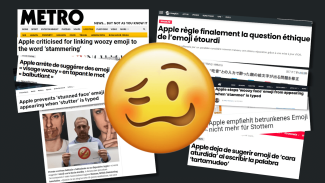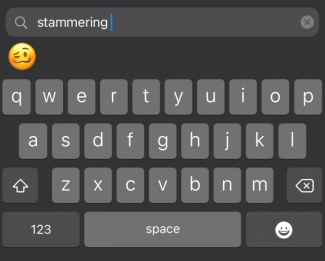
Apple & 'Woozy Face'
Service

How we stopped the tech giant Apple from linking the woozy face emoji to stammering.
Summary
When STAMMA learned that Apple devices were suggesting the 'Woozy face' emoji whenever the word stammering was typed, we made a complaint and mobilised the international stammering community making it an international story. Apple then acted and dropped the linkage.
Outcome: Apple users who stammer will no longer be effectively 'mocked' whenever they type the word stammering.
Background
Early in June 2021, when one of our helpline volunteers typed in the word 'stammering' to her Apple device when composing a message, the 'woozy face' emoji popped up in the suggested emoji box.
The woozy face emoji — sometimes called ‘vertigo face’ — has a wavy mouth and a closed eye (see picture). It was added to Apple's roster in 2018 and is supposed to depict being drunk, dazed, infatuated or tired and emotional.

The volunteer took offence that the emoji was being linked to stammering in this way, and told us about it.
Complaint
On 16th June, we complained to Apple about it. They responded and asked us to find out what models and operating systems were affected. So we took to Twitter, as it was then, and Facebook to ask our followers. Hundreds responded — the emoji appeared across all models and operating systems and people didn’t hold back from telling us how offensive and upsetting they found it:
"This is ableist, as sometimes people who stammer make facial expressions when experiencing a block, and this almost mimics that. I hope Apple realise this and apologise." (Ellie)
One of our patrons, the author David Mitchell, said on Twitter "Pls cld someone at @Apple tell me if this is calculated mockery, a stab at puerile humour or the act of a disgruntled ex-employee? I'm honestly curious."

Our research indicated that the problem lay solely with Apple — not any other platform, not with the creators of the emoji, not with the Unicode Consortium.
Investigation
On the 6th July, we wrote to Apple, asking for a response to our complaint. We pointed out that stammering can be seen as a disability under the Equalities Act 2010, as for many people it can severely impair day-to-day functions and for adults is lifelong. As such, this linkage between stammering and the woozy face emoji, showing as it does someone drunk, confused or in love, could constitute harassment under the Equalities Act.
Action
We then issued a press release, telling the world what our members had told us, that this linkage was offensive. In it, STAMMA CEO Jane Powell stated:
"This is demeaning and damaging. Stammering is how some people talk. Treating it as a joke is stigmatising. It can leave people embarrassed about how they sound, bullied and ashamed which can affect their mental health, careers and relationships."
It was picked up by the Metro newspaper in the UK as well as Apple-centred news sites around the world, in multiple languages. We were contacted by supporters around the world, some of whom knew people at Apple or businesses that worked in partnership with Apple, vowing to chase this up. Meanwhile we reached out to our international community, and working with the International Stuttering Association and VivaVoce Assoziatione in Italy, we started plotting a coordinated campaign, with a petition on change.org/NotWoozyFace along with a social media campaign (#NotWoozyFace).
We checked out 'stammering' in 15 different languages and discovered that the Woozy Face appeared in each. We sought legal advice, held late night and crack of dawn meetings and were totally ready to take on Apple, globally.
Outcome
At 4:30pm on 22nd July 2021, we received word that Apple had stopped the woozy face emoji from appearing when typing the word ‘stammering’ in its iOS update 14.7.
In its Diversity and Equality statement, Apple said: "Across Apple, we've strengthened our long-standing commitment to making our company more inclusive and the world more just. Where every great idea can be heard. And everybody belongs".
But there was no apology or direct acknowledgement from Apple that they had fed the stigma associated with stammering.
Coverage
The news was picked up around the world (see the picture at the top of the page), with headlines reporting on the change made by Apple.
Here are some links to online articles about the story:
- Stutter charity calls out Apple for 'stammering' emoji gaffe – Apple Insider
- Apple Called Out by UK Charity STAMMA After its Emoji Appears to Mock People With Stutter – Tech Times
- Apple devices suggest woozy face emoji for stammering – 9to5Mac
- Apple attacked for insulting people who stutter – Phone Arena
- Apple stops suggesting 'woozy face' emoji when typing the word 'stammering' - iMore.com
- UK stammer charity slams Apple over 'ableist' and 'demeaning' emoji search - iMore.com
- British Stammering Association blasts Apple for linking 'woozy face' emoji to stammering – Mac Daily News
- People are upset about Apple's recommended emoji for stammering – Cult of Mac
- British charity hits out at Apple over 'stammering' emoji suggestion – The Apple Post
- Stutter charity calls out Apple for 'stammering' emoji gaffe – Tech Telegraph
- Apple releases an update: the 'vertigo face' emoji will no longer appear when users enter the word 'stuttering' – iPhone Wired.
Social media reaction
Here's how some of our followers responded:

Comment
Regardless of whether Apple intended to demean people who stammer, they did. Their lack of an apology and their failure to even respond to our complaint, shows they have a long road ahead to make good on that commitment to the stammering community across the globe.



